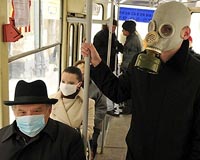| . |  |
. |
Geneva (AFP) April 20, 2010 Last April's discovery of a previously unknown flu virus in Mexico and the United States sparked fears of a deadly pandemic and set off a chain of unprecedented action by health authorities. But a year on, questions linger as to whether a decision by the World Health Organization to declare swine flu a pandemic, thereby unleashing the slew of health measures, was over-dramatic or even tainted by commercial interests. "It's a decision which costs huge amounts of money, which frightened people throughout the world unnecessarily," said Paul Flynn, a British parliamentarian who led a Council of Europe inquiry on the issue. The WHO's decision resulted "in the disruption the changing of priorities in health services which were concentrating on swine flu instead of concentrating on matters which were far more important to save lives," he charged. Flynn noted that huge sums were spent on anti-virals and vaccines, which went largely wasted as skeptical populations refused to get vaccinated. In France, for instance, the purchase of 94 million vaccines cost the state around 600 million euros, but only less than 10 percent of the population went to get vaccinated. "It's a waste," said French senator Marie-Christine Blandin, who compiled a report on the management of swine flu. While governments rushed to cancel massive vaccine orders as vaccination campaigns fell flat, critics turned to the big winners in the flu episode -- pharmaceutical firms. Swiss giants Novartis and Roche, for instance, both reported exceptional results last year thanks to the unexpected boost from vaccine or flu medication orders. Indeed, critics have raised the question of big pharma's influence on the WHO's treatment of the epidemic. "Everything that mixes money and health is a problem of credibility for the decisions which are taken," said Didier Tabuteau, a professor at the Institute of Political Studies in Paris. However, many scientists jumped to the defense of the WHO. "A lot of the criticism is political. I've not heard criticism from any virologist," said John Oxford, a virologist and professor at Queen Mary's School of Medicine and Dentistry in Britain. After all, the A(H1N1) virus was a new one and it showed rapid spread since its discovery late April. According to data compiled from health authorities, it was killing more young, healthy people than other seasonal flu viruses -- which tend to be more lethal for the old and vulnerable. Based on guidelines drawn up on pandemic, the WHO's committee of experts in June therefore recommended that a pandemic be declared. The move led to a series of action, with countries rushing to stockpile anti-virals and pharmaceutical companies ordered to develop vaccines. Although the WHO said when declaring the pandemic that it was a "moderate" one, it had also warned against complacency, noting the virulence of a flu such as the 1918 Spanish flu which killed at least 40 million people. The intensity of the reaction to the flu may also have unwittingly led the public to develop an impression that the flu was more deadly -- like the lethal Spanish flu or bird flu -- than it turned out to be. This month, as the WHO launched a probe into the handling of the flu, the UN health agency's flu chief Keiji Fukuda acknowledged with hindsight that a better response would have involved "less confusion." Critics believe that the swine flu episode may have done more harm to the WHO than good. "The great danger is that the world will say you cried wolf, you frightened us about things that didn't happen and that the authority of the WHO could be undermined," said Flynn. "If there is a very dangerous virus in future, no one might take notice of the warning and people could die," he added. The WHO review panel's final overall report on the handling of the pandemic is due to be ready by this autumn.
Share This Article With Planet Earth
Related Links Epidemics on Earth - Bird Flu, HIV/AIDS, Ebola
 Pandemic not over, WHO flu probe hears
Pandemic not over, WHO flu probe hearsGeneva (AFP) April 14, 2010 Experts who planned the global drive against swine flu on Wednesday warned that the pandemic was not yet over and rejected charges they had been unduly influenced by the drug companies. Their comments came at the end of the first meeting of an external review set up by World Health Organisation to probe the much criticised international response to the new A(H1N1) influenza virus over the pa ... read more |
|
| The content herein, unless otherwise known to be public domain, are Copyright 1995-2010 - SpaceDaily. AFP and UPI Wire Stories are copyright Agence France-Presse and United Press International. ESA Portal Reports are copyright European Space Agency. All NASA sourced material is public domain. Additional copyrights may apply in whole or part to other bona fide parties. Advertising does not imply endorsement,agreement or approval of any opinions, statements or information provided by SpaceDaily on any Web page published or hosted by SpaceDaily. Privacy Statement |